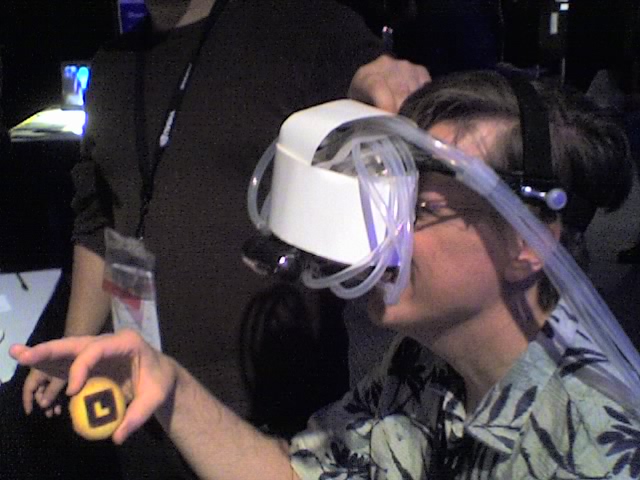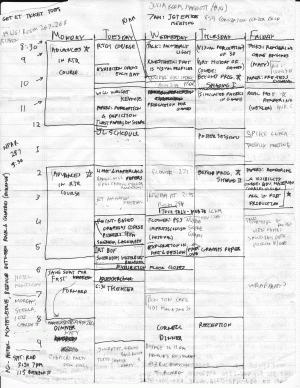Although GPU Pro 2 isn’t even out yet, Wolfgang has started the call for articles for the next book in the series. The first GPU Pro was very good (even better in my opinion than the ShaderX series which preceded it), and the second book in the series (judging from its table of contents) seems likely to be strong as well.
Category Archives: Miscellaneous
I3D 2011 Call for Participation
I received this CfP a week ago, but I was traveling so hadn’t had the time to post it earlier. I3D has always been a very good conference, with a high percentage of usable real-time rendering papers. This year’s conference was especially strong. Five of the papers were by people who had implemented the described techniques in commercial games (Crysis 2, Batman: Arkham Asylum, Civilization V, Toy Story 3 The Video Game, and Dark Void), and many of the other papers were also interesting and relevant (all papers are linked from Ke-Sen’s website).
Now is the opportunity to submit papers for I3D 2011, which will take place in San Francisco in late February. The full Call follows:
I3D 2011 Call for Participation
Submission System is now open!
Paper submission deadline: October 22, 2010
Conference info: http://www.i3dsymposium.org
Submission system: http://precisionconference.com/~i3d
Conference Date: February 18th – 20th, 2011
Location: Marriott Fisherman’s Wharf, San Francisco, CA
I3D is the leading-edge conference for real-time 3D computer graphics and human interaction, and 2011 marks the 25th year since the first conference gathering. We invite you to submit papers, posters, and interactive demos across the entire range of topics in interaction, interactive 3D graphics, and games. The fall deadline provides the perfect outlet for your summer work.
Topics include, but are not limited to:
- Interaction devices and techniques
- 3D game techniques
- Interactive modeling
- Level-of-detail approaches
- Pre-computed lighting
- Visibility computation
- Real-time surface shading
- Fast shadows, caustics and reflections
- Imposters and image-based techniques
- Animated models
- GPU techniques
- Navigation methods
- Interactive visualization
- Virtual and augmented reality
- User studies of interactive techniques and applications
Paper submissions should be up to 8 pages in length and adhere to ACM SIGGRAPH style guidelines. The submission of a video to accompany the paper is encouraged. Papers will be peer-reviewed in a single-blind process and authors notified by e-mail.
Please visit the conference website at http://www.i3dsymposium.org for additional information, submission details, and further updates.
Send questions to:
- general (at) i3dsymposium.org (for general inquiries)
- papers (at) i3dsymposium.org (for questions on paper submission)
- posters (at) i3dsymposium.org (for questions on posters & demos)
Important Dates:
- Paper submissions due: October 22nd, 2010
- Poster and demo submissions due: December 17th, 2010
- Paper notifications: Dec 3, 2010
- Poster and demo notifications: Jan 7, 2011
- Conference: February 18th – 20th, 2011
Benoit Mandelbrot dies at 85
I just received this news from Solomon Boulos, that Mandelbrot passed away. Would anyone have discovered this area of math if he hadn’t? Whatever the answer, many of us have whiled away at least a few happy hours rendering 2D and 3D fractals, and Benoit was the one who started it all.
Here are a few links in honor of Mandelbrot. I happened to have these stored away for the blog, time to put them up.
- DirectX 9 Mandelbulb demo scene code in 1k
- The Mandelbox
- Iñigo Quilez’s site has a fair bit on fractals and on all sorts of other graphics goodness.
Peripherally-Related Links
Here are a bunch of links to things that are graphical, but definitely not about hard-core interactive rendering. Basically, it’s stuff I found of interest that has a visual and technical component and that I’m compelled by the laws of the internet to pass on. It’s a pile of candy, so I recommend reading just a bit of this post each day. Which of course you won’t do, but at least your teeth won’t rot and you won’t gain 3 pounds.
- An unusual thing at SIGGRAPH 2010 was a talk about visualizing the 6502 processor. It’s got heavyweights such as Greg James (formerly of NVIDIA) working on it. This is a famous chip: Apple II, Atari 2600, Commodore 64, etc. They simulate (not emulate) the chip by creating and manipulating a polygonal model of it. See their website for much more.
- The day has finally arrived: Microsoft Office 2010 requires a GPU supporting DirectX 9.0c, along with 64 MB of GPU memory. I was interested to see such a mainstream application requiring graphics hardware. Admittedly, DirectX 9.0c was released in 2004, but still.
- Polygonal sculpture. Wireframe teapot. Painted people. Cartoon hotel room. Mirror man. Shadow rendering error. See, the world can simulate all sorts of media and artifacts.
- In a similar vein, some lovely images of light that look simulated (link from Vincent Scheib).
- Showing a person’s eyes both open and shut in the same photo is surprising (and not Photoshop). Turns out this effect is due to the rolling shutter used by many cameras. Works for video, too. The first chapter of Andrew Glassner’s Other Notebook talks about simulating this type of shutter and many others (readable on Google Books).
- This was quite clever, a music video that uses Google maps and street view to pull in your childhood neighborhood.
- Some sharp and colorful synthetic holograms of buildings.
- Is there nothing that cannot be a user interface?
- The game “Devil’s Tuning Fork” has a mind-frying rendering style (link from Morgan McGuire).
- Wow, chromakeying truly is omnipresent.
- Animated reverse perspective.
- I have a few RenderMan walking teapots, but never realized there was quite this much interest in them.
- Which reminds me of renderfarms. Marcos Fajardo mentioned in his talk at SIGGRAPH about the Arnold raytracer that interactivity is critical, as CPU time is $0.10 an hour while artists cost $40 an hour. I expect artists actually cost more (insurance, office space, tools, etc.), and it’s interesting to note that the spot instance price for Amazon’s cloud computers is now as low as $0.03, depending.
- This game effect is simply magical (and one day will be as common as, well, 3D graphics).
- There’s a new system for 3D scans of building interiors. I like the concept of grad students carrying packs of lasers – what could possibly go wrong?
- This projection onto a building is just plain brilliant (how can those people just walk by?!). More info here; the clip has better sound but is not continuous.
- A fine illusion, and a similar one with Legos. Another illusion that amazes, though it takes a little effort to understand.
- I mentioned the Meta Cookie project before. I finally got around to downloading my ancient cell phone’s pictures, so here’s proof I survived the process:

Live Real-Time Demos at SIGGRAPH
So one problem with SIGGRAPH is that you hear about the cool thing that you missed and didn’t even know about until it was too late. Here’s one that’s getting repeated: the Computer Animation Festival’s Live Real-Time Demos session. Hall B, 4:30-5:15 pm Tuesday and Wednesday; I just caught the tail-end of Monday’s show and it was worth seeing, so I’ll go back for the rest tomorrow.
What else didn’t you miss yet? Hmmm, in Emerging Technologies Sony’s 360-degree autostereoscopic display is cute, I’ve heard the 3D multitouch table is very worthwhile, and you must try out the Meta Cookie (have someone take your picture while you’re in the headgear, it’s something your grandchildren will want to see). I was also interested to see QuintPixel from Sharp, as it justified their earlier Quattron “four primary colors” display.
More later – Mental Images reception time.
Ray Tracing News v23 n1 is out
Just in time for SIGGRAPH (so I wouldn’t get those “when’s the next issue coming out?” questions), here it is.
GPU Ray Tracing BOF at SIGGRAPH 2010
There will be a Birds of a Feather gathering at SIGGRAPH 2010 about GPU Ray Tracing: Wednesday, 4:30-6 pm, Room 301 A.
A brief description from Austin Robison: We won’t have a projector or desktop machines set up, but please feel free to bring your laptops to show off what you’ve been working on! Additionally, I’ve created a Google Group mailing list that I hope we can use, as a community, to share insights and ask questions about ray tracing on GPUs not tied to any specific API or vendor. Please sign up and share your news, experiences and ideas: http://groups.google.com/group/gpu-ray-tracing.
Another SIGGRAPH Scheduler
 I’ve messed around with various scheduling methods over the years for SIGGRAPH, but find I dislike the form factor of PDA-like devices: you can see a few hours, or maybe a day’s activities at best. Taking notes can be tiresome, you need lots of clicks needed to find stuff, and sometimes the battery dies.
I’ve messed around with various scheduling methods over the years for SIGGRAPH, but find I dislike the form factor of PDA-like devices: you can see a few hours, or maybe a day’s activities at best. Taking notes can be tiresome, you need lots of clicks needed to find stuff, and sometimes the battery dies.
So for the past few years I’ve locked onto classic graphite stick & cellulose technology. Honestly, I like it a lot: folds up and fits in my pocket, it’s easy to see conflicts among events, I can instantly figure out when I’m free, and lots of room on the back for notes and whatnot. At the end of the conference I automatically have a hardcopy, no printing necessary. I mention it here as an honestly useful option, as this low-tech approach works for me. The main drawback is that you look like a nerd to other nerds. Hey, I like my iPod Touch, I’ll put the SIGGRAPH Advanced Program on it with Discover, but the sheet o’ paper will be my high-level quick & dirty way to navigate and write down information. It’s sort of how I like RememberTheMilk for reminders more than Google Calendar: I can enter data very simply, without time wasted navigating the UI. Now if only the sheet of paper would automatically unfold when I take it out of my pocket, I could increase efficiency by 0.43 seconds.
Random graphics paper title generator
Try it – it’s a blast (keep hitting “refresh” to see new titles). Here’s a few that I got:
- Bidirectional Rendering of Caustics for Light Fields
- Reflective Normal-mapped Light Fields
- Rendering of Inverse Geometry
- Texturing of Multi-resolution Geometry using Polygonal Approximation
- Displacement Mapping of Reflective Geometry for Surfaces
Can’t tell them from the real paper titles…
GPU Pro is out, and more
A few days before the official release date of July 1, the book GPU Pro is out. Think “ShaderX, but now with color”. The example programs and source code are free to download. As mentioned before, more about it at Wolfgang Engel’s book blog.